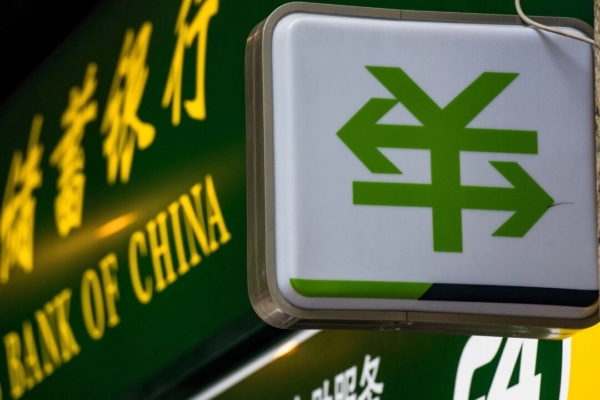The internationalization of the Chinese yuan has not met the goals of the Chinese Communist Party, primarily due to its limited convertibility and usability, lagging far behind the US dollar and being restricted to usage in countries like Russia facing severe sanctions, with almost no other choices available.
Since 2021, the global trade settlement in Chinese yuan has increased from about 2% to 3% to around 4.3%. While this signifies a significant growth percentage-wise, the yuan still lags far behind the dollar (47%) and the euro (23%) in overall trade settlement. The main reason for this growth is the expanding trade relationship between China and Russia, with both countries using the yuan to bypass sanctions imposed in US dollar transactions.
The Chinese state-run media Global Times misleadingly claimed that the yuan’s share in global trade settlement reached a new record of 24%. In reality, the yuan does not represent 24% of global trade settlement. The truth is that China now settles about 24% of its international trade in yuan. Considering China’s trade volume, this means that less than 5% of global trade is settled in yuan, closer to economic reality.
The trade settled in yuan between Russia and China has seen significant growth but only accounts for a small fraction of the global market. For instance, in 2023, the total trade value between the two countries reached around $240 billion, with approximately $68.7 billion settled in yuan. However, due to concerns that secondary sanctions may decrease such trade and yuan usage, Chinese banks have been stricter in scrutinizing these transactions, often finding Russian partners or clients on US sanction lists, causing hesitancy to proceed with transactions.
Delays caused by intensified scrutiny have led to Russian companies cancelling transactions with Chinese companies and banks. Even in a limited choice of countries, the slight increase in yuan usage now faces risks, further highlighting the minimal possibility of the yuan challenging the dollar as a global currency.
Trade settlement is just one measurement of internationalization; another crucial factor is the composition of foreign exchange reserves. The US dollar constitutes 58% of global central bank reserves, while the yuan only represents 2.3%. Despite the dominant position of the dollar in global forex reserves, the dollar’s share is underestimated due to the IMF’s Special Drawing Rights (SDR).
Central banks hold SDR in addition to US dollars and other currencies, but since the dollar’s weight in the SDR basket is over 43% and the yuan only accounts for 12%, holding SDR further increases indirect exposure to the dollar. This implies that the dollar’s actual dominance in global reserves is even greater than when holding dollars directly.
Foreign exchange trading volume is a critical indicator of currency usage: the dollar accounts for 88% in all pair trading, while the yuan only represents 7%. In trade financing, due to China’s lower interest rates, the yuan rises to 6%. Meanwhile, despite the high US interest rates, the dollar still dominates 84% of global trade financing. This shows that traders prefer to pay higher rates to hold dollars, even at a discount, rather than hold yuan.
The main obstacles to the internationalization of the yuan persist, including the Chinese government’s control over the yuan exchange rate, limiting its market influence. Additionally, restrictions on the yuan’s convertibility and usability hinder its global expansion, while the dollar’s dominance remains strong, mainly due to oil pricing in dollars.
Discussions between Riyadh and Beijing on China paying for Saudi oil in yuan to promote the yuan’s internationalization have encountered significant hurdles. Any major shift in yuan-settled oil trade could take decades. For exporting countries like Saudi Arabia, accepting yuan depends on effectively utilizing the currency. As the yuan is not widely accepted in global trade or finance, oil exporters face currency risks and costs when using yuan. Moreover, as the Saudi currency is pegged to the dollar, Riyadh has no incentive to weaken the dollar’s availability or value.
Chinese leader Xi Jinping hopes for changes in these trends in the future. His visit to Saudi Arabia in December 2022 marked a new phase in the relationship, expanding from oil to a broader partnership. For instance, Saudi Vision 2030, a long-term plan to strengthen institutional, financial, and cultural ties between the two countries. However, as Saudi Arabia is the largest foreign military sales customer of the US, they understand that as long as oil is priced in dollars, Washington will provide weapons and military protection. Shifting to the yuan implies not only economic losses but may also impact this crucial defense relationship.
In conclusion, the increase in yuan usage for trade settlement is largely driven by the growth in Sino-Russian trade. However, due to secondary sanctions, such trade now faces risks. Except for Russia, most countries are unwilling to accept or hold yuan due to its limited convertibility, usability, and China’s exchange rate control. Even when US interest rates reach their highest levels in decades, traders still prefer dollar financing. Additionally, the anticipated US rate cuts will only make dollar financing more attractive.
Dr. Antonio Graceffo is a China economic analyst who has worked and lived in Asia for over twenty years. He holds a bachelor’s degree from Shanghai Institute of Physical Education, a master’s degree in Business Administration from Shanghai Jiao Tong University, and is currently researching defense issues at the American Military University. He is the author of the book “Beyond the Belt and Road: China’s Global Economic Expansion” (2019).

